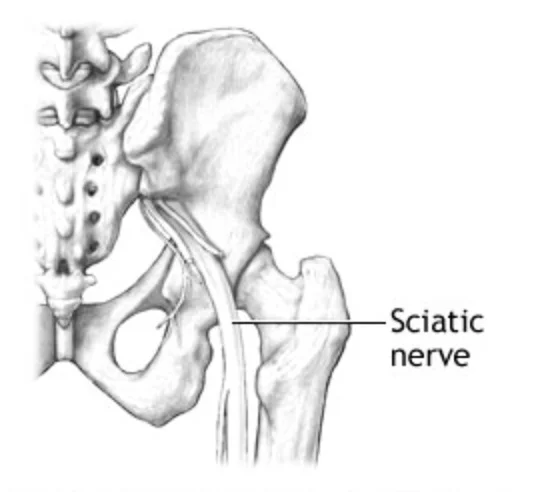Pain Crisis: Dealing with Sciatica
Sciatica is back and leg pain attributed to the sciatic nerve, which helps (via its terminal branches) innervate the legs and feet. There are 2 main causes of sciatic pain, which commonly presents as pain running down the side or back of the thigh, sometimes all the way to the toes.
The first potential cause is lumbar disc dysfunction, which can be a herniated, degenerated or subluxed disc which is either pushing directly on the sciatic nerve or has created inflammation that is causing the sciatic nerve to be grumpy. Disc issues tends to be more serious, since the precious spine is involved, and can be more of a structural issue which may or may not need surgical or hands on intervention and lots of time to heal. If the disc is subluxed and is physically pushing on the nerve, or the nerve root is being compressed because of degeneration, it will be difficult to remedy without serious intervention. If the disc is herniated, normally symptoms will resolve in a few weeks to a few months, since in this case its the fluid that has escaped from the nucleus that is causing inflammation around the nerve root. When the fluid becomes absorbed, the inflammation will subside and so will the sciatic pain. In all cases of disc dysfunction, the spine will be more vulnerable going forward.
Second cause of sciatic pain is Piriformis syndrome, which is basically a tight piriformis muscle pressing on the sciatic nerve as it emerges from the pelvis. This case is much easier to resolve since it is muscular rather than structural.
What causes Piriformis Syndrome?
1. Driving for long distances
2. Ballet or Modern Dance that works the legs in turn-out. The piriformis muscle is an external rotator of the hip so this makes sense.
3. Pelvic rotation. The piriformis muscle has a strong pull on the sacrum and when the pelvis ia rotated one of the piriformis muscles will be tight (this can happen from pregnancy, childbirth, leg length discrepancy or just plain faulty alignment)
BTW: SI joint pain is often also caused by a tight piriformis. So follow the steps below for SI joint pain.
What to do? When in doubt, Roll it Out!
Strategy for Piriformis Syndrome:
1. Rollout Pirformis (this will feel good for either cause of nerve pain). Use a foam roller or myofascial release ball and roll out the Piriformis muscles. You can sit on the roller or ball and find the spot between your sit bone and your ASIS that is incredibly painful. It shouldn't be too hard to find! It should reproduce your sciatic pain when you're rolling it out. You might want to cry. But go gingerly and stalwart.
2. Work the adductors by squeezing a ball or magic circle between your legs, or doing leg springs with a ball between your ankles. And doing internal rotation in leg springs and footwork.

